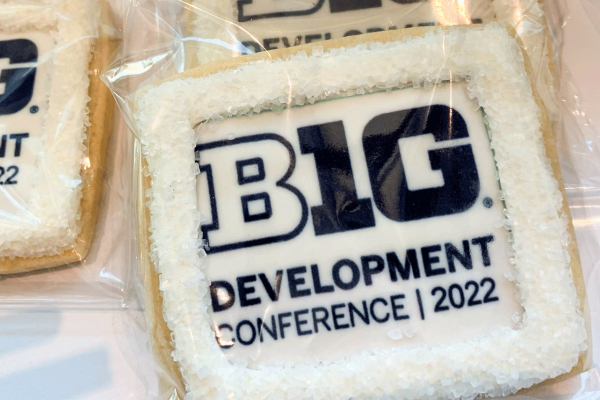Fromme shares Design Thinking with the Big Ten

Adam Fromme, Assistant Professor of Teaching, presented at the annual Big Ten Development conference this past week. The 3-day conference brings together advancement and development leadership from across the Big Ten conference for professional development.
Prof. Fromme’s talk introduced how Design Thinking can be used in the workplace. Specifically, presenting ways an organization’s leadership can adjust goals, benchmarks, and expectations to foster innovation and creativity.
There were four major takeaways from his presentation:
- Identify what type of problem you are facing. Different problems require different strategies, affecting how resources should be allocated. These resources include project specific time, money and talent. While well-defined problems use narrowing strategies (Hill Climbing, Problem Reduction, etc.) that find the most “probable” answer—the one perfect solution; ill-defined problems need strategies that widen the search field (Elaboration, Re-encoding, Constraint relaxation, etc.) to seek what answers are “possible”—and then to choose the most preferable solution. Problems that address the needs of people often fall into this second group. Yet too often we use narrowing strategies when working on complex problems. To be nimble, it is important to know what type of problem you are seeking to solve, so those resources can be put to best use.
- For complex problems finding good insight is important. Good insight is information that provides new understanding and leads to good decisions during the design process. To gain good insight, it is critical to have participation by the people that the problem affects (to help understand the current situation). As well as performing rapid experimentation to test ideas in low-risk settings (to better understand what the goal is). In design, the people we are interested in are treated as experts in the problems that they face. By asking and experimenting with them throughout the process, the feedback loop is shortened. This insures that the work remains focused is on satisfying their goal—not perfecting our solution. Bottomline, you succeed when they succeed, not the other way around.
- Finding good insight can feel daunting. Because of this, too often problem solvers make risky assumptions. This is the wrong approach. Instead, design offers a wide set of tools to understand the perspectives of our experts. In general, tools fall into three categories: tools to learn about the starting point (the current situation), tools to learn about the goal point (the desired situation), and tools to explore possible solutions. By identifying what part of the problem is being explored, the best tool for the job can be chosen. This will not only increase the chance of discovering helpful information but allow the problem to be understood more quickly.
- Everyone is creative, but creativity rarely is felt unless it is fostered. First and foremost, this happens when people have permission to play. “Play mode” is different than “Decide mode,” where important choices are made. Play mode is a set time where people are removed from pressure of finding the ‘right’ answer and wild ideas can be shared (free from judgement); where writing, drawing, building or other physical activities serve as drivers of conversations; and where a new idea can grow from a spark to a flame.
These takeaways highlight the broader role Design Thinking can play in the workplace for organizations seeking innovation. For some, these ideas may feel commonplace or intuitive—this is awesome—that means they are already on the way to thinking like a designer. But for others—looking at those overly analytical, type-A personalities—this type of work is not intuitive, and this process can feel uncomfortable, unfocused or frustrating. This is where the Design Thinking mindset, strategies, and tools can help. They give guidance to that walking-around-a-dark-room feeling when you are not quite sure what you are looking for.
This overview offered a snapshot to the conference attendees of a larger Innovation program that Prof. Fromme co-developed for Ohio State’s Office of Advancement. In that course, participants take a 9-month dive into this mindset and gain practice using design tools. The ultimate goal of the program is migrating these creative problem-solving strategies into their workplace. Work is underway to expand this program and, in doing so, create new hotspots for innovation in industry that are ready to receive students from the Department of Design, as well as students across the university in the Design Thinking minor.

